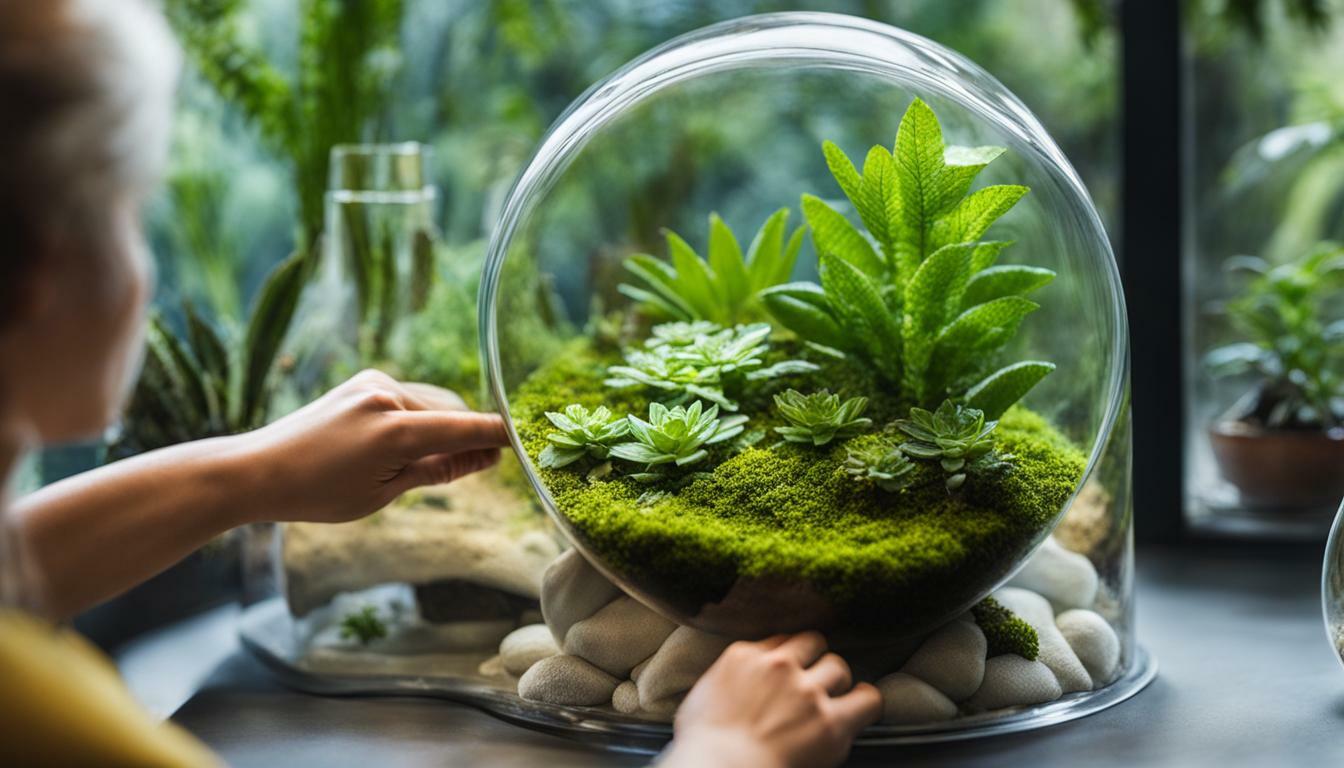Maintaining a clean and stain-free terrarium is essential for the health and longevity of your plants. Terrariums create a beautiful and contained environment for your green companions, but without proper care, glass stains can become a significant problem. Terrarium care is not as daunting as it may seem, and by implementing a few simple techniques, you can prevent glass stains and create a thriving ecosystem for your plants.
Key Takeaways:
- Keep terrariums out of direct sunlight to prevent magnification and burning of plants.
- Ensure adequate indirect light for plant survival, and consider supplemental grow lights if needed.
- Avoid placing terrariums near heat sources, as this can quickly kill plants.
- Maintain regular trimming and removal of diseased or dying plants to prevent the spread of problems.
- Periodically clean the glass of the terrarium to ensure proper light penetration without using harsh cleaning products.
By following these key takeaways, you will be well on your way to mastering terrarium care and preventing glass stains. The health and vibrancy of your plants will thank you for the extra care and attention.
Understanding Terrarium Care and Maintenance
Proper terrarium care and maintenance are crucial in creating a thriving indoor garden and preventing unsightly glass stains. With the right techniques and practices, you can ensure that your terrarium remains a healthy and visually appealing environment for your plants to thrive.
One of the key factors in terrarium care is providing the right lighting conditions. While terrariums should be kept away from direct sunlight to prevent magnification and burning of plants, they still require adequate indirect light to survive. If natural light is limited, you can use supplemental grow lights or fluorescent lights to provide the necessary illumination.
Placement is another important aspect of maintaining a healthy terrarium. Avoid placing your terrarium near heat sources as this can quickly lead to the demise of your plants. Heat from radiators or direct contact with heating vents can cause stress or overheating, resulting in a negative impact on the plants’ health.
Regular maintenance is essential in preventing the spread of problems in your terrarium. Trimming overgrown plants and removing diseased or dying plants not only keeps your terrarium visually appealing but also prevents the spread of diseases and pests. Additionally, periodic cleaning of the terrarium glass is necessary to ensure that light can reach your plants effectively. However, it’s important to avoid using harsh cleaning products that can harm your plants.
Best Practices for Terrarium Care and Maintenance:
- Prevent over-watering by using a spray bottle and absorbing excess water with a paper towel if necessary.
- Generally, terrarium plants do not require fertilization as they are kept small.
- Select plants that are well-suited for the specific type of terrarium you have, considering factors such as light requirements and growth habits.
- Mold can be a common issue in terrariums. Increase airflow, use hydrogen peroxide or chamomile tea to control mold, or introduce springtails as a preventive measure.
- Promptly remove dead plants to maintain a balanced environment and prevent the spread of diseases.
- Trim overgrown plants to preserve space and scale in your terrarium.
- Regularly clean the glass with purified water to remove mineral residue and ensure optimal light penetration.
By following these best practices, you can master terrarium care and maintenance, creating a thriving indoor garden that is free from glass stains and provides a healthy and beautiful environment for your plants.
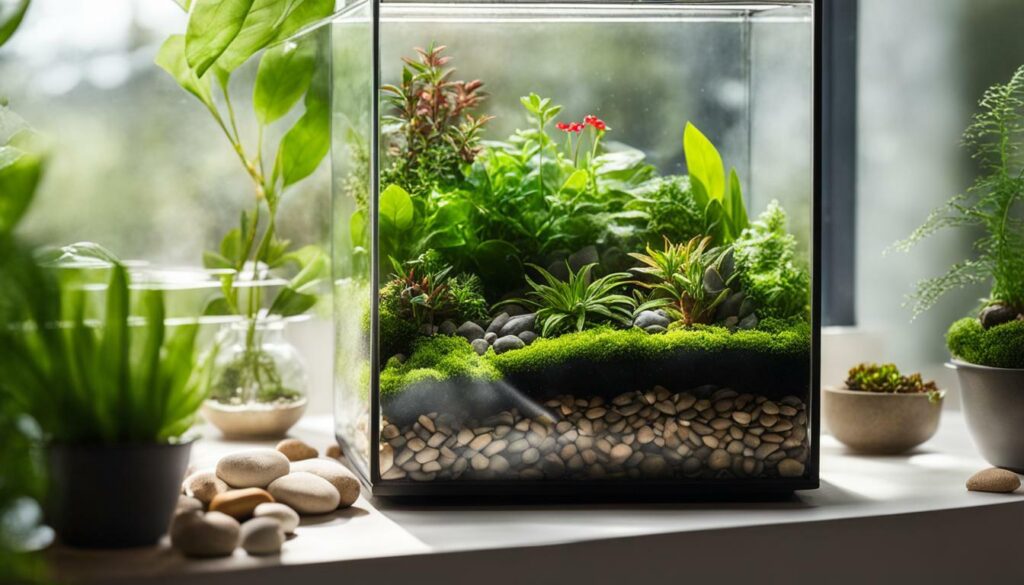
| Best Practices for Terrarium Care and Maintenance |
|---|
| Prevent over-watering by using a spray bottle and absorbing excess water with a paper towel if necessary. |
| Generally, terrarium plants do not require fertilization as they are kept small. |
| Select plants that are well-suited for the specific type of terrarium you have, considering factors such as light requirements and growth habits. |
| Mold can be a common issue in terrariums. Increase airflow, use hydrogen peroxide or chamomile tea to control mold, or introduce springtails as a preventive measure. |
| Promptly remove dead plants to maintain a balanced environment and prevent the spread of diseases. |
| Trim overgrown plants to preserve space and scale in your terrarium. |
| Regularly clean the glass with purified water to remove mineral residue and ensure optimal light penetration. |
Creating the Ideal Environment for Terrariums
Achieving the ideal environment for your terrarium is a key factor in preventing glass stains and promoting the health of your plants. Proper lighting, temperature, and placement are essential components in creating a thriving terrarium ecosystem. By following these guidelines, you can ensure optimal conditions for your plants while keeping glass stains at bay.
Lighting and Placement
When it comes to lighting, terrariums should be kept out of direct sunlight to prevent magnification and burning of plants. Instead, provide indirect light by placing your terrarium near a window with filtered or diffused light. If natural light is limited, consider using supplemental grow lights or fluorescent lights to ensure your plants receive the necessary light energy for photosynthesis.
Additionally, it’s crucial to position your terrarium away from heat sources such as heaters or radiators. Excessive heat can quickly damage or kill your plants, compromising their overall health and increasing the risk of glass stains. Maintaining a moderate and consistent temperature is key to creating an optimal terrarium environment.
Maintenance and Cleaning
Regular maintenance plays a vital role in preventing glass stains and maintaining a visually appealing terrarium. Trim overgrown plants to preserve space and scale in the terrarium, and promptly remove any diseased or dying plants to prevent the spread of problems. Periodically cleaning the glass of your terrarium is also necessary to ensure adequate light reaches the plants. However, avoid using harsh cleaning products that can potentially harm your plants. Instead, opt for gentle cleaning solutions or simply wipe the glass with a soft cloth and purified water.
Dos and Don’ts
Here are some dos and don’ts when it comes to terrarium care and reducing glass stains:
- Do maintain proper humidity levels by misting your terrarium with water when needed. Use a spray bottle for controlled and precise watering, and absorb any excess moisture with a paper towel if necessary.
- Don’t overwater your terrarium, as excess water can lead to stagnant conditions and encourage the growth of mold and other issues.
- Do select plants that are suitable for the specific type of terrarium you have. Different terrariums require different levels of humidity, lighting, and care. Choose plants that thrive in the conditions you can provide.
- Don’t neglect mold prevention. Increase airflow within your terrarium by periodically removing the lid or opening a vent. Consider using natural remedies like hydrogen peroxide or chamomile tea to discourage mold growth. Introducing springtails, tiny beneficial insects, can also help control mold as a preventive measure.
- Do regularly clean the glass with purified water to remove mineral residue that can obstruct light penetration. A clean and clear glass surface will ensure optimal conditions for your plants.
Remember, mastering terrarium care requires attention to humidity, watering, lighting, mold prevention, and regular maintenance. By creating the ideal environment for your terrarium and implementing these care techniques, you can enjoy a thriving and glass stain-free terrarium filled with healthy and vibrant plants.
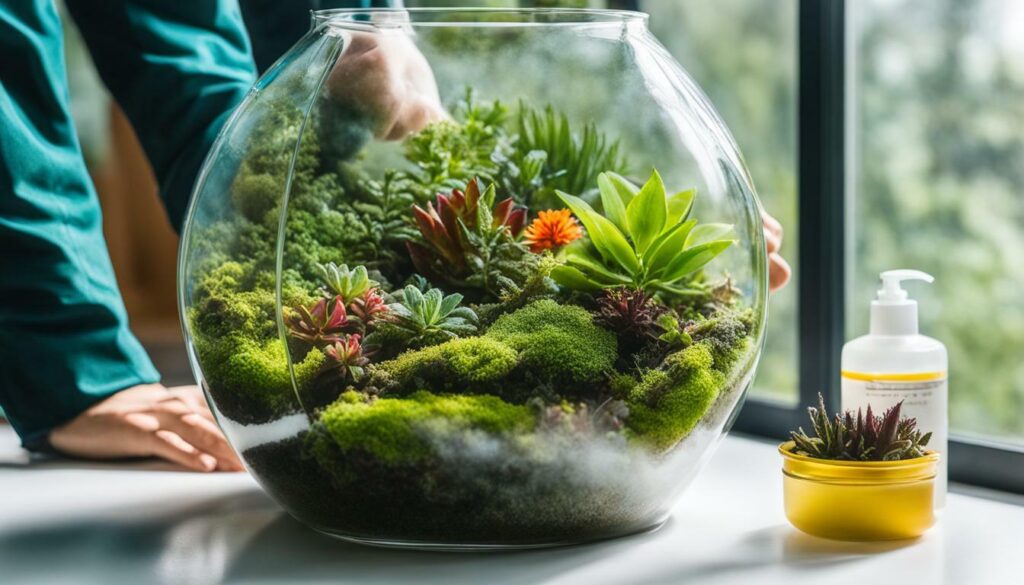
| Do’s | Don’ts |
|---|---|
| Maintain proper humidity levels | Overwater your terrarium |
| Select suitable plants for your terrarium | Neglect mold prevention |
| Regularly clean the glass with purified water | Use harsh cleaning products |
Maintaining Proper Lighting and Placement
Proper lighting and strategic placement of your terrarium are essential in preventing glass stains and ensuring the longevity of your plants. Terrariums should be positioned away from direct sunlight, as the glass can magnify the sun’s rays and burn your delicate plants. Instead, opt for a location with indirect light, such as near a north-facing window or in a well-lit room.
If your terrarium is situated near heat sources, such as radiators or vents, the excess heat can quickly lead to plant wilting or even death. It’s crucial to keep your terrarium in a cool and well-ventilated area to maintain a suitable temperature for the plants.
Regular maintenance is key in preventing overgrowth and maintaining a balanced environment within your terrarium. Trim any overgrown plants to preserve space and scale in the container. Similarly, promptly remove any diseased or dying plants to prevent the spread of problems among your other greenery.
Cleaning the glass of your terrarium periodically is necessary to ensure that adequate light reaches the plants. However, it’s important to avoid the use of harsh cleaning products, as they can harm your plants. Instead, opt for a gentle solution of purified water and a soft cloth to wipe away any accumulated dust or dirt. This will not only prevent glass stains but also enhance the overall aesthetic appeal of your terrarium.
Remember, mastering terrarium care goes beyond lighting and placement. It also involves attention to humidity, watering, mold prevention, and regular maintenance. By implementing these tips and techniques, you can create a thriving terrarium that brings joy and beauty to your space.
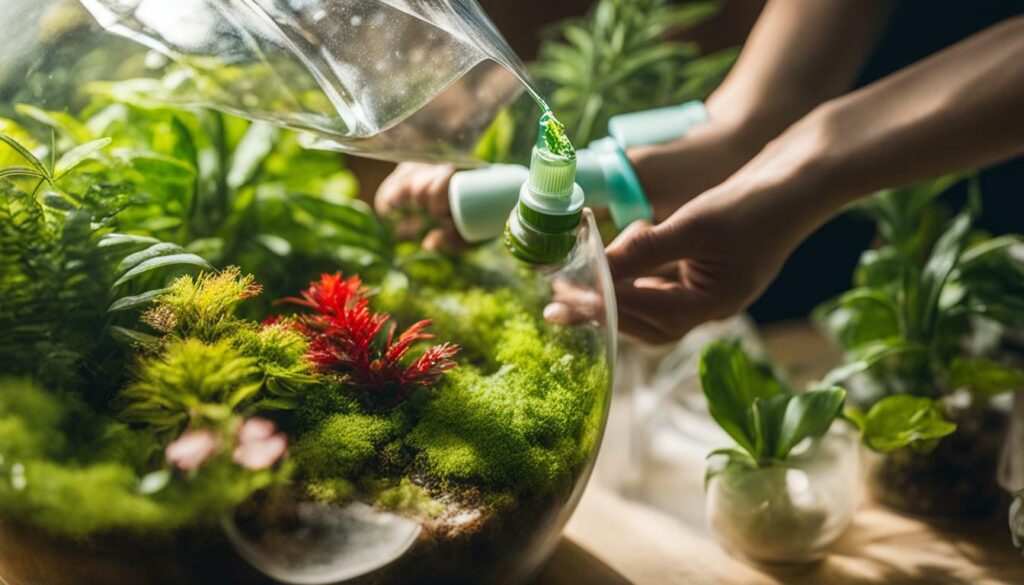
Proper management of watering and humidity levels is integral to preventing glass stains in your terrarium and fostering a healthy plant environment. Over-watering is a common mistake that can lead to stagnant water, mold growth, and ultimately, glass stains. To avoid this, it is recommended to water your terrarium using a spray bottle, ensuring that the water is distributed evenly across the plants and soil. This method allows for better control over the amount of water applied, preventing excess moisture from accumulating on the glass.
In addition to watering, maintaining the right humidity level is crucial for the well-being of your terrarium. Most terrarium plants thrive in environments with moderate humidity, typically ranging between 40% to 60%. To achieve and maintain the ideal humidity, you can use a hygrometer to monitor the moisture level in the terrarium. If the humidity is too high, opening the lid for a short period can help release excess moisture. If the humidity is too low, misting the plants with purified water can provide the necessary moisture.
It is important to note that different types of terrariums, such as closed or open containers, may require different watering and humidity management techniques. Closed terrariums generally retain more moisture and require less frequent watering, while open terrariums allow for better air circulation and may require more regular watering. Understanding the specific needs of your terrarium and adjusting watering and humidity levels accordingly will help prevent glass stains and promote the growth of healthy plants.
| Terrarium Type | Watering Frequency | Ideal Humidity Range |
|---|---|---|
| Closed Terrarium | Once every 2-4 weeks | 40-60% |
| Open Terrarium | Once every 1-2 weeks | 40-60% |
A well-maintained terrarium with proper watering and humidity levels not only prevents glass stains but also provides an optimal environment for your plants to thrive.
Key Points:
- Water your terrarium using a spray bottle to prevent over-watering and excessive moisture on the glass.
- Maintain moderate humidity levels between 40% to 60% by adjusting watering frequency and misting the plants if needed.
- Closed terrariums require less frequent watering compared to open terrariums.
- Use a hygrometer to monitor and adjust the humidity level in your terrarium accordingly.
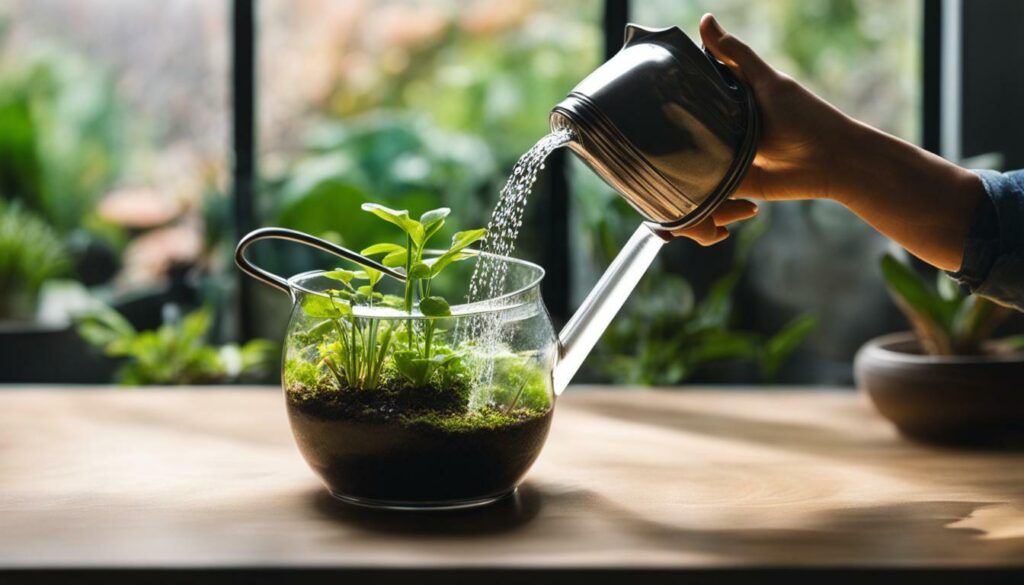
Overall, proper management of watering and humidity levels is essential for preventing glass stains and creating a healthy environment for your terrarium plants. Understanding the specific needs of your terrarium and following these guidelines will ensure the longevity and beauty of your terrarium while keeping the glass clean and clear for optimal plant growth.
Selecting Suitable Plants for Your Terrarium
Choosing the right plants for your terrarium is crucial in preventing glass stains and ensuring a harmonious plant ecosystem. Terrariums create a unique microclimate, and not all plants can thrive in such conditions. When selecting plants, consider their growth habits, light requirements, and tolerance to high humidity.
Table 1: Recommended Terrarium Plants
| Plant Name | Light Requirements | Humidity Tolerance | Comment |
|---|---|---|---|
| Ferns | Indirect light | High | Low maintenance |
| Succulents | Bright, indirect light | Low to moderate | Drought-tolerant |
| Orchids | Bright, indirect light | Moderate to high | Elegant and vibrant |
| Pothos | Low to bright, indirect light | Moderate to high | Air-purifying properties |
Source: Author’s expertise
“The key is to choose plants that are adapted to the unique environment of a terrarium. Ferns are an excellent choice as they thrive in high humidity and low light conditions. Succulents, such as Haworthia and Echeveria, can add a touch of elegance to your terrarium while requiring less water. Orchids bring a splash of color and charm, but they prefer bright, indirect light. Pothos, a versatile and low-maintenance plant, does well in terrariums with a wide range of light conditions.” – Terrarium Care Expert
Remember, when incorporating multiple plants in one terrarium, consider their size and growth rate. Some plants may outgrow the space, leading to overcrowding and poor airflow. Strive for a balanced and visually appealing arrangement, creating a miniature garden within your glass enclosure. By carefully selecting suitable plants, you can minimize the risk of glass stains and ensure a thriving terrarium ecosystem.
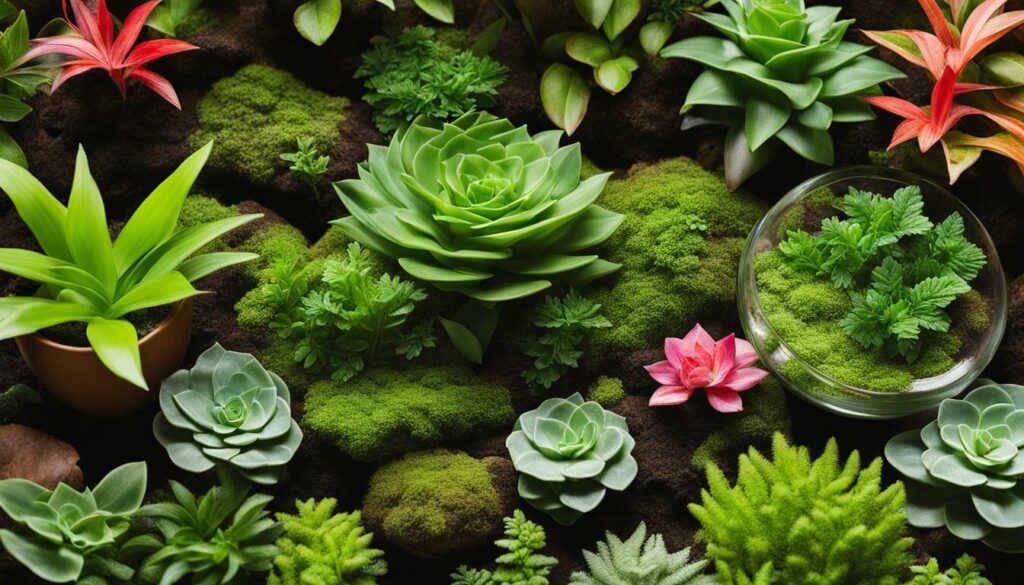
Preventing and Managing Mold in Terrariums
Mold can be a common issue in terrariums, but with proper techniques, you can prevent its growth and maintain a stain-free glass enclosure. Here are some guidelines to help you effectively manage mold in your terrarium:
Increase Airflow:
Good airflow is essential for preventing mold growth in terrariums. Keep the lid slightly ajar or consider using a mesh or screen top to allow for better ventilation. This helps to reduce condensation and excess moisture, creating an environment less conducive to mold development.
Use Natural Remedies:
Incorporating natural remedies can be an effective way to combat mold in your terrarium. One solution is to use hydrogen peroxide or chamomile tea. Mix a small amount of hydrogen peroxide or brewed chamomile tea with water, then spray the solution onto the affected areas. These remedies help to kill mold and prevent its further growth without causing harm to your plants.
Introduce Springtails:
Springtails are tiny organisms that feed on decaying plant matter and mold. They can be beneficial additions to your terrarium as they help to keep mold populations in check. You can introduce springtails by collecting them from outdoor environments, such as rotting logs or leaf litter, or purchase them from a reputable source.
By implementing these preventive measures and regular maintenance, you can effectively manage mold growth in your terrarium and maintain a clean, stain-free glass enclosure.
| Key Techniques to Prevent Mold in Terrariums |
|---|
| Increases airflow by keeping the lid slightly ajar or using a mesh top. |
| Use natural remedies like hydrogen peroxide or chamomile tea to kill mold. |
| Introduce springtails to help control mold populations. |
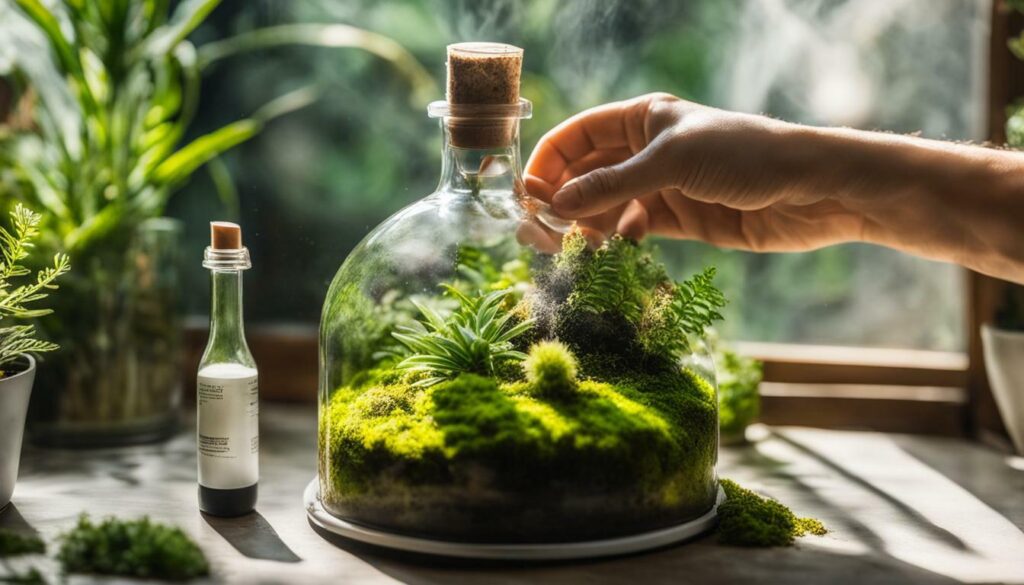
“Good airflow is the key to preventing mold growth in terrariums. Keeping the lid slightly open or using a mesh top allows for proper ventilation and reduces excess moisture.” – Terrarium Care Expert
Regular Trimming and Maintenance
Regular trimming and maintenance are vital in preventing overgrowth and preserving the aesthetic appeal of your terrarium. As plants grow, they may outgrow their designated space, obstructing the view of other plants and disrupting the overall balance of your terrarium. Trimming back overgrown plants not only maintains the desired scale and proportions but also allows light to reach all plants equally.
To trim your terrarium plants, use clean and sharp pruning shears or scissors. Start by identifying the parts of the plants that need trimming, such as long stems or excessive foliage. Carefully remove these parts, making clean cuts just above a node or leaf joint to encourage healthy regrowth. It’s important to avoid tearing or crushing the stems, as this can lead to plant stress or infection.
In addition to trimming, regular maintenance tasks in your terrarium should include the removal of diseased or dying plants. Diseased plants can quickly spread pathogens to neighboring plants, compromising the overall health of your terrarium. Promptly removing these plants and any fallen leaves or debris will help maintain a balanced environment and reduce the risk of pests or diseases.
Remember to clean the glass of your terrarium periodically to ensure that light can reach all plants effectively. Avoid using harsh chemical cleaners, as they can harm delicate plant surfaces. Instead, opt for a gentle cleaner or simply wipe the glass with a soft cloth and purified water. This will remove any dust, smudges, or mineral residue that might hinder light penetration and hinder plant growth.
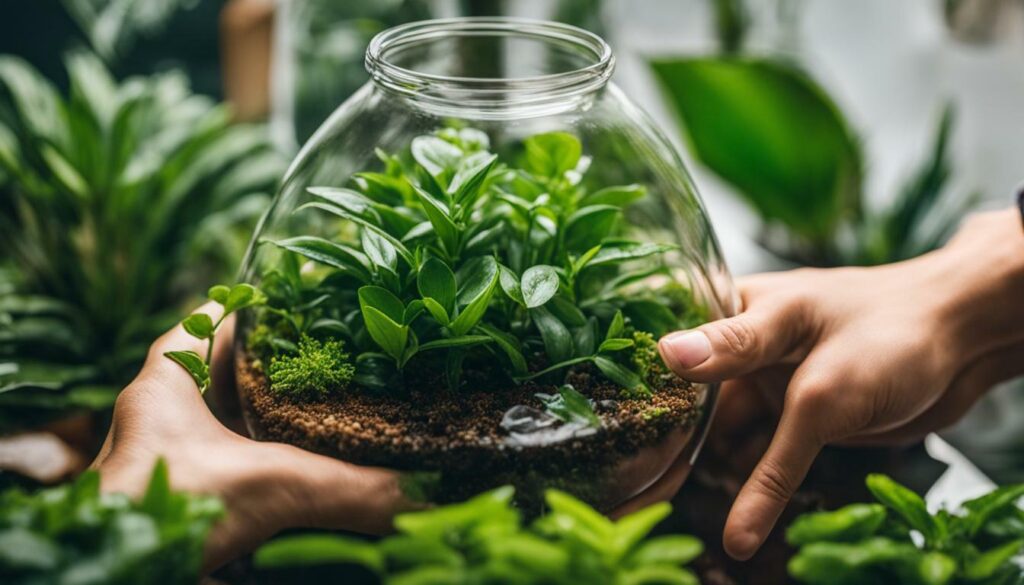 Regular trimming and maintenance are crucial to prevent overgrowth and maintain the aesthetic appeal of your terrarium.
Regular trimming and maintenance are crucial to prevent overgrowth and maintain the aesthetic appeal of your terrarium.| Key Points: |
|---|
| – Regularly trim overgrown plants to maintain scale and proportions |
| – Remove diseased or dying plants to prevent the spread of pathogens |
| – Clean the glass periodically with a gentle cleaner or purified water |
“Regular maintenance ensures that your terrarium remains visually pleasing and provides a healthy growing environment for your plants.”
Trimming Tips:
- Use clean and sharp pruning shears or scissors
- Make clean cuts just above a node or leaf joint
- Avoid tearing or crushing the stems
Dealing with Mineral Residue on Glass
Over time, mineral residue can accumulate on the glass of your terrarium, hindering light transmission, but with proper care, you can maintain a crystal-clear view. Regular cleaning of the glass is essential to ensure optimal light penetration and showcase the beauty of your terrarium.
To remove mineral residue effectively, avoid using harsh cleaning products that could harm your plants. Instead, opt for a natural solution by using purified water and a soft cloth or sponge. Gently wipe the glass in a circular motion until the residue is removed. For stubborn stains, you can add a small amount of white vinegar to the water to help break down the minerals.
It’s important to note that abrasive materials or cleaning agents containing ammonia or bleach should be avoided, as they can damage the glass and harm your plants. Additionally, avoid spraying water directly onto the glass, as it may seep into the terrarium and saturate the soil, leading to over-watering.
A regular cleaning schedule is recommended to prevent mineral residue buildup. Aim to clean the glass every two to four weeks, depending on the rate of residue accumulation. By maintaining a clean glass surface, you’ll ensure that your terrarium remains a visually stunning centerpiece in your home or office.
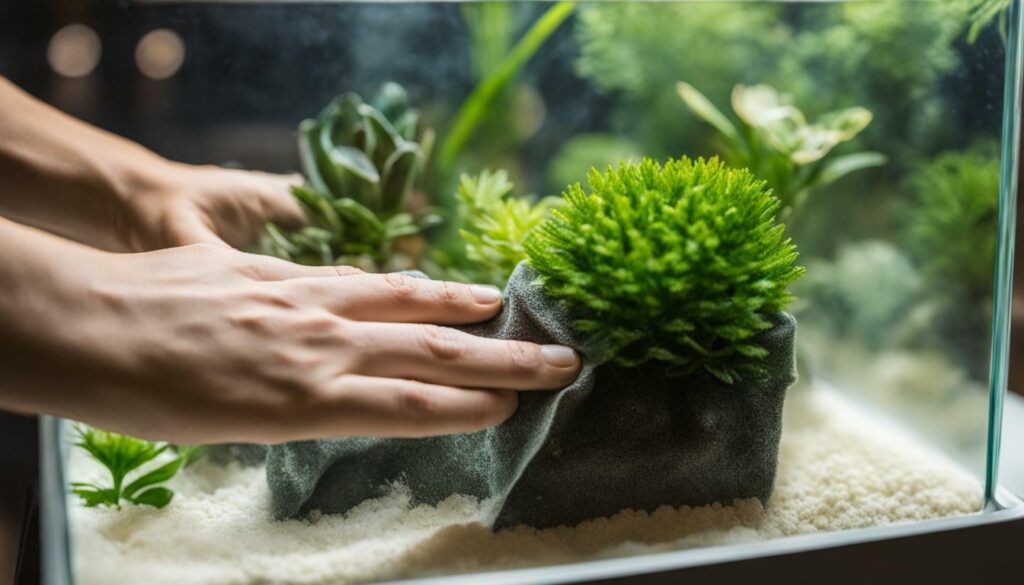
| Do: | Don’t: |
|---|---|
| Use purified water for cleaning. | Use harsh cleaning products or chemicals. |
| Gently wipe the glass with a soft cloth or sponge. | Scrub the glass vigorously. |
| Add a small amount of white vinegar to aid in removing stubborn residue. | Use abrasive materials or tools. |
| Follow a regular cleaning schedule every two to four weeks. | Spray water directly onto the glass. |
With these simple cleaning tips and consistent maintenance, you’ll be able to enjoy a clear and unobstructed view of your terrarium’s vibrant plant life. Remember, a well-maintained terrarium not only brings natural beauty into your space but also contributes to the overall health and longevity of your plants. Happy terrarium care!
What Are the Best Methods for Preventing Glass Stains in a Terrarium?
When it comes to preventing glass stains in a terrarium, following the ultimate terrarium watering tips is crucial. By using a spray bottle to water the plants, avoiding overwatering, and wiping the glass regularly, you can keep your terrarium looking clean and free of unsightly stains.
Conclusion
By following these tips and techniques, you can prevent glass stains and create a flourishing terrarium that brings joy and beauty to your indoor space.
Mastering terrarium care is essential for preventing glass stains and maintaining a healthy environment for your plants. Terrariums should be kept out of direct sunlight to prevent magnification and burning of plants. Adequate indirect light is necessary for plant survival, and supplemental grow lights or fluorescent lights can be used if needed. Placing terrariums near heat sources can quickly kill plants.
Regular maintenance such as trimming overgrown plants and removing diseased or dying plants is important to prevent the spread of problems. Cleaning the glass of the terrarium periodically is necessary to ensure light reaches the plants, but harsh cleaning products should be avoided. Over-watering should be prevented by using a spray bottle and absorbing excess water with a paper towel if necessary.
Fertilization is generally not needed as terrarium plants should be kept small. Selecting plants that thrive in the specific type of terrarium is crucial. Mold can be a common issue in terrariums and can be managed by increasing airflow, using hydrogen peroxide or chamomile tea, or introducing springtails as a preventive measure. Dead plants should be promptly removed to maintain a balanced environment. Overgrown plants should be trimmed back to preserve space and scale in the terrarium. Regular cleaning of the glass with purified water is recommended to remove mineral residue.
Overall, mastering terrarium care requires attention to humidity, watering, lighting, mold prevention, and regular maintenance. By implementing these practices, you can enjoy the beauty of your terrarium without the worry of glass stains, creating a thriving ecosystem in your indoor space.
FAQ
Why is terrarium care important?
Terrarium care is important for preventing glass stains and maintaining a healthy environment for your plants.
How do I prevent glass stains in my terrarium?
To prevent glass stains, keep your terrarium out of direct sunlight to avoid magnification and burning of plants.
What type of lighting do terrariums need?
Terrariums require adequate indirect light for plant survival. Supplemental grow lights or fluorescent lights can be used if needed.
Can I place my terrarium near heat sources?
It is recommended to keep terrariums away from heat sources as they can quickly kill plants.
How often should I trim my terrarium plants?
Regular maintenance, including trimming overgrown plants and removing diseased or dying plants, is important to prevent the spread of problems.
How do I clean the glass of my terrarium?
Periodically cleaning the glass of your terrarium is necessary to ensure light reaches the plants. Avoid using harsh cleaning products and instead use purified water.
How can I prevent over-watering in my terrarium?
Use a spray bottle for watering and absorb excess water with a paper towel if necessary to prevent over-watering.
Do terrariums require fertilization?
Fertilization is generally not needed for terrarium plants, as they should be kept small. Selecting plants that thrive in a terrarium environment is crucial.
How do I manage mold in my terrarium?
To manage mold in a terrarium, increase airflow, use hydrogen peroxide or chamomile tea, or introduce springtails as a preventive measure.
What should I do with dead plants in my terrarium?
Dead plants should be promptly removed from the terrarium to maintain a balanced environment.
How do I deal with mineral residue on the glass of my terrarium?
Regularly clean the glass of your terrarium with purified water to remove mineral residue and ensure optimal light penetration.

